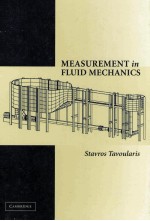

MEASUREMENT IN FLUID MECHANICSPDF电子书下载
- 电子书积分:13 积分如何计算积分?
- 作 者:STAVROS TAVOULARIS
- 出 版 社:CAMBRIDGE UNIVERSITY PRESS
- 出版年份:2005
- ISBN:
- 页数:354 页
PART ONE GENERAL CONCEPTS 3
1 Flow properties and basic principles 3
1.1 Forces,stresses,and the continuum hypothesis 3
1.2 Measurable properties 4
1.3 Flow velocity and velocity fields 5
1.4 Analytical description of flows 7
1.5 The choice of analytical approach 8
1.6 Similarity 11
1.7 Patterns of fluid motion 16
QUESTIONS AND PROBLEMS 17
REFERENCES 18
2 Measuring systems 19
2.1 Measuring systems and their components 19
2.2 Static response of measuring systems 23
2.3 Dynamic response of measuring systems 31
2.4 Distortion,loading,and cross-talk 40
QUESTIONS AND PROBLEMS 41
REFERENCES 43
3 Measurement uncertainty 45
3.1 Measurement errors 45
3.2 Measurement uncertainty 47
3.3 Uncertainty of derived properties 48
3.4 Rounding of reported values 51
QUESTIONS AND PROBLEMS 53
REFERENCES 54
4 Signal conditioning,discretization,and analysis 55
4.1 Fundamentals of electric and electronic circuits 55
4.2 Analogue signal conditioning 63
4.3 Discretization of analogue signals 68
4.4 Statistical analysis of signals 74
4.5 Frequency analysis of signals 84
QUESTIONS AND PROBLEMS 94
REFERENCES 95
5 Background for optical experimentation 98
5.1 The nature of light 98
5.2 Light propagation through media 101
5.3 Illumination 107
5.4 Light scattering 123
5.5 Light transmission,sensing,and recording 128
5.6 Characteristics of seeding particles 132
QUESTIONS AND PROBLEMS 142
REFERENCES 144
6 Fluid mechanical apparatus 147
6.1 Producing the desired flow 147
6.2 Changing the flow area 148
6.3 Flow management 151
6.4 Wind tunnels 154
6.5 Water tunnels and towing tanks 157
6.6 Turbulence and shear generation 159
6.7 Model testing 163
QUESTIONS AND PROBLEMS 165
REFERENCES 165
7 Towards a sound experiment 169
7.1 Planning the experiment 169
7.2 Safety 170
7.3 Qualitative assessment 170
7.4 Record keeping 174
7.5 Scientific ethics 175
QUESTIONS AND PROBLEMS 176
REFERENCE 176
PART TWO MEASUREMENT TECHNIQUES 179
8 Measurement of flow pressure 179
8.1 What exactly is pressure? 179
8.2 Pressure-measuring instrumentation 180
8.3 Wall-pressure measurement 188
8.4 In-flow pressure measurement 193
8.5 Dynamic response and testing of pressure-measuring systems 200
QUESTIONS AND PROBLEMS 203
REFERENCES 205
9 Measurement of flow rate 208
9.1 Direct methods 208
9.2 Positive-displacement flow meters 209
9.3 Venturi,nozzle,and orifice-plate flow meters 211
9.4 Open-channel flow measurement 212
9.5 Averaging Pitot tubes 213
9.6 Laminar flow elements 213
9.7 Rotameters 214
9.8 Vortex-shedding flow meters 214
9.9 Drag flow meters 215
9.10 Turbine flow meters 215
9.11 Ultrasonic flow meters 216
9.12 Electromagnetic flow meters 217
9.13 Coriolis flow meters 217
9.14 Thermal-mass flow meters 218
9.15 Selection of flow meter 219
QUESTIONS AND PROBLEMS 219
REFERENCES 220
10 Flow visualization techniques 221
10.1 Overview 221
10.2 Marker techniques 222
10.3 Optical techniques 231
10.4 Radiation emission techniques 242
10.5 Enhancement of flow visualization records 243
QUESTIONS AND PROBLEMS 244
REFERENCES 246
11 Measurement of local flow velocity 249
11.1 Thermal anemometry 249
11.2 Laser Doppler velocimetry 264
11.3 Ultrasonic Doppler velocimetry 274
11.4 Particle displacement methods 275
11.5 Measurement of wind velocity 282
QUESTIONS AND PROBLEMS 284
REFERENCES 287
12 Measurement of temperature 290
12.1 A practical temperature scale 290
12.2 Thermometers 291
12.3 Dynamic response of thermometers 296
12.4 Thermochromic materials 299
12.5 Radiation emission methods 301
12.6 Optical techniques 304
QUESTIONS AND PROBLEMS 304
REFERENCES 305
13 Measurement of composition 307
13.1 Sample analysis 307
13.2 Thermal probes 310
13.3 Electric conductivity probes 311
13.4 Light-scattering methods 312
13.5 Laser-induced fluorescence 316
13.6 Particulate measurement 318
13.7 Void measurement 321
QUESTIONS AND PROBLEMS 323
REFERENCES 324
14 Measurement of wall shear stress 328
14.1 Estimates from measured velocity profiles 328
14.2 Estimates from pressure differences 332
14.3 Floating-element balances 335
14.4 Thermal techniques 336
14.5 Electrochemical method 338
14.6 Optical techniques 339
QUESTIONS AND PROBLEMS 342
REFERENCES 343
15 Outlook 345
Index 349
- 《乳腺超声经典诊断学 中文翻译版》(美)A.Thomas Stavros著;王知力译 2017
- 《THE LIMITS OF REGULATION A CRITICAL ANALYSIS OF CAPITALIST DEVELOPMENT》STAVROS MAVROUDEAS 2012
- 《QUANTIFICATION IN LC AND GC A PRACTICAL GUIDE TO GOOD CHROMATOGRAPHIC DATA》HANS-HOACHIM KUSS AND STAVROS KROMIDAS 2009
- 《MEASUREMENT IN FLUID MECHANICS》STAVROS TAVOULARIS 2005
- 《Advances in communications and media research Volume 11》Anthony v.Stavros 2016
- 《MODELLING AND FORECASTING HIGH FREQUENCY FINANCIAL DATA》STAVROS DEGIANNAKIS 2015
- 《DIFFERENTIAL EQUATIONS AND APPLICATIONS IN ECOLOGY EPIDEMICS AND POPULATION PROBLEMS》STAVROS N.BUSENBERG 1981
- 《金融机构的绩效 效率、创新和监管》(美)帕特里克 T.哈克(Patrick T.Harker),(美)斯塔夫罗斯 A.泽尼奥斯(Stavros A.Zenios)编;徐诺金,赵蓉,危勇等译 2005
- 《中国“80后”大学教师胜任力评价研究=RESEARCH ON THE EVALUATION OF CHINA'S POST 80s GENERATION UNIVERSITY TEACHERS' CO》黄艳著 2013
- 《解读好莱坞:电影的空间与意义》Deborah Thomas著;李达义,曹玉玲译 2004
- 《会说话的星图 星座篇》徐历涛著 2014
- 《可靠性工程与风险管理 第3辑 英文版》赵衍刚编 2012
- 《竞争战略 全译珍藏版》(美)迈克尔·波特(Michael E. Porter)著 2012
- 《中国材料名师讲坛 第1辑》谢建新主编 2012
- 《翻译能力的培养》舍夫娜,阿达巴编 2012
- 《大学生外语口语焦虑 自我图式的视角 for university students: in the view of self-schema》巫文胜著 2014
- 《都柏林大学的教育内涵与实践 探索世界高水平大学发展之路 explore the development of the world high-level university》李全宏编著 2013
- 《物理学 卷1 力学和热学 医学、生物等专业适用 英文改编版原书第4版》AlanGiambattista,BettyMcCarthyRichardson著 2013
